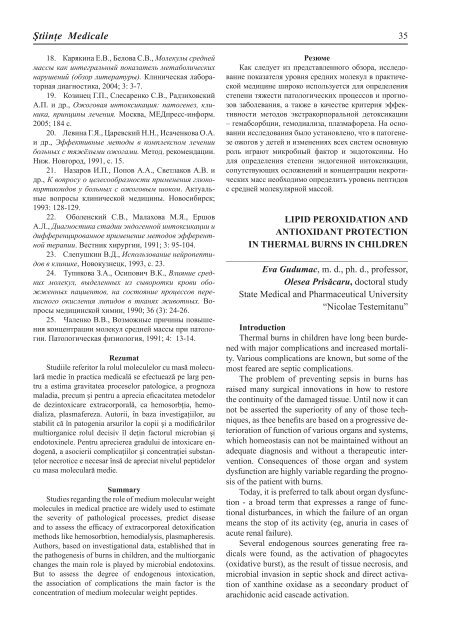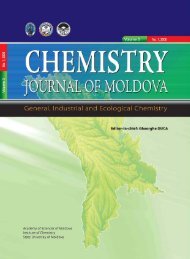stiinte med 1 2012.indd - Academia de ÅtiinÅ£e a Moldovei
stiinte med 1 2012.indd - Academia de ÅtiinÅ£e a Moldovei
stiinte med 1 2012.indd - Academia de ÅtiinÅ£e a Moldovei
Create successful ePaper yourself
Turn your PDF publications into a flip-book with our unique Google optimized e-Paper software.
Ştiinţe Medicale<br />
18. Карякина Е.В., Белова С.В., Молекулы средней<br />
массы как интегральный показатель метаболических<br />
нарушений (обзор литературы). Клиническая лабораторная<br />
диагностика, 2004; 3: 3-7.<br />
19. Козинец Г.П., Слесаренко С.В., Радзиховский<br />
А.П. и др., Ожоговая интоксикация: патогенез, клиника,<br />
принципы лечения. Москва, МЕДпресс-информ.<br />
2005; 184 с.<br />
20. Левина Г.Я., Царевский Н.Н., Исаченкова О.А.<br />
и др., Эффективные методы в комплексном лечении<br />
больных с тяжёлыми ожогами. Метод. рекомендации.<br />
Ниж. Новгород, 1991, c. 15.<br />
21. Назаров И.П., Попов А.А., Светлаков А.В. и<br />
др., К вопросу о целесообразности применения глюкокортикоидов<br />
у больных с ожоговым шоком. Актуальные<br />
вопросы клинической медицины. Новосибирск;<br />
1993: 128-129.<br />
22. Оболенский С.В., Малахова М.Я., Ершов<br />
А.Л., Диагностика стадии эндогенной интоксикации и<br />
дифференцированное применение методов эфферентной<br />
терапии. Вестник хирургии, 1991; 3: 95-104.<br />
23. Слепушкин В.Д., Использование нейропептидов<br />
в клинике, Новокузнецк, 1993, с. 23.<br />
24. Тупикова З.А., Осипович В.К., Влияние средних<br />
молекул, выделенных из сыворотки крови обожженных<br />
пациентов, на состояние процессов перекисного<br />
окисления липидов в тканях животных. Вопросы<br />
медицинской химии, 1990; 36 (3): 24-26.<br />
25. Чаленко В.В., Возможные причины повышения<br />
концентрации молекул средней массы при патологии.<br />
Патологическая физиология, 1991; 4: 13-14.<br />
Rezumat<br />
Studiile referitor la rolul moleculelor cu masă moleculară<br />
<strong>med</strong>ie în practica <strong>med</strong>icală se efectuează pe larg pentru<br />
a estima gravitatea proceselor patologice, a prognoza<br />
maladia, precum şi pentru a aprecia eficacitatea meto<strong>de</strong>lor<br />
<strong>de</strong> <strong>de</strong>zintoxicare extracorporală, ca hemosorbţia, hemodializa,<br />
plasmafereza. Autorii, în baza investigaţiilor, au<br />
stabilit că în patogenia arsurilor la copii şi a modificărilor<br />
multiorganice rolul <strong>de</strong>cisiv îl <strong>de</strong>ţin factorul microbian şi<br />
endotoxinele. Pentru aprecierea gradului <strong>de</strong> intoxicare endogenă,<br />
a asocierii complicaţiilor şi concentraţiei substanţelor<br />
necrotice e necesar însă <strong>de</strong> apreciat nivelul pepti<strong>de</strong>lor<br />
cu masa moleculară <strong>med</strong>ie.<br />
Summary<br />
Studies regarding the role of <strong>med</strong>ium molecular weight<br />
molecules in <strong>med</strong>ical practice are wi<strong>de</strong>ly used to estimate<br />
the severity of pathological processes, predict disease<br />
and to assess the efficacy of extracorporeal <strong>de</strong>toxification<br />
methods like hemosorbtion, hemodialysis, plasmapheresis.<br />
Authors, based on investigational data, established that in<br />
the pathogenesis of burns in children, and the multiorganic<br />
changes the main role is played by microbial endotoxins.<br />
But to assess the <strong>de</strong>gree of endogenous intoxication,<br />
the association of complications the main factor is the<br />
concentration of <strong>med</strong>ium molecular weight pepti<strong>de</strong>s.<br />
35<br />
Резюме<br />
Как следует из представленного обзора, исследование<br />
показателя уровня средних молекул в практической<br />
медицине широко используется для определения<br />
степени тяжести патологических процессов и прогнозов<br />
заболевания, а также в качестве критерия эффективности<br />
методов экстракорпоральной детоксикации<br />
– гемабсорбции, гемодиализа, плазмафореза. На основании<br />
исследования было установлено, что в патогенезе<br />
ожогов у детей и изменениях всех систем основную<br />
роль играют микробный фактор и эндотоксины. Но<br />
для определения степени эндогенной интоксикации,<br />
сопутствующих осложнений и концентрации некротических<br />
масс необходимо определить уровень пептидов<br />
с средней молекулярной массой.<br />
LIPID PEROXIDATION AND<br />
ANTIOXIDANT PROTECTION<br />
IN THERMAL BURNS IN CHILDREN<br />
_______________________________________<br />
Eva Gudumac, m. d., ph. d., professor,<br />
Olesea Prisăcaru, doctoral study<br />
State Medical and Pharmaceutical University<br />
“Nicolae Testemitanu”<br />
Introduction<br />
Thermal burns in children have long been bur<strong>de</strong>ned<br />
with major complications and increased mortality.<br />
Various complications are known, but some of the<br />
most feared are septic complications.<br />
The problem of preventing sepsis in burns has<br />
raised many surgical innovations in how to restore<br />
the continuity of the damaged tissue. Until now it can<br />
not be asserted the superiority of any of those techniques,<br />
as thee benefits are based on a progressive <strong>de</strong>terioration<br />
of function of various organs and systems,<br />
which homeostasis can not be maintained without an<br />
a<strong>de</strong>quate diagnosis and without a therapeutic intervention.<br />
Consequences of those organ and system<br />
dysfunction are highly variable regarding the prognosis<br />
of the patient with burns.<br />
Today, it is preferred to talk about organ dysfunction<br />
- a broad term that expresses a range of functional<br />
disturbances, in which the failure of an organ<br />
means the stop of its activity (eg, anuria in cases of<br />
acute renal failure).<br />
Several endogenous sources generating free radicals<br />
were found, as the activation of phagocytes<br />
(oxidative burst), as the result of tissue necrosis, and<br />
microbial invasion in septic shock and direct activation<br />
of xanthine oxidase as a secondary product of<br />
arachidonic acid casca<strong>de</strong> activation.

















